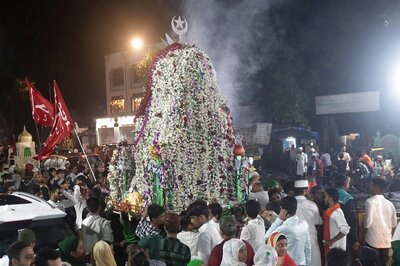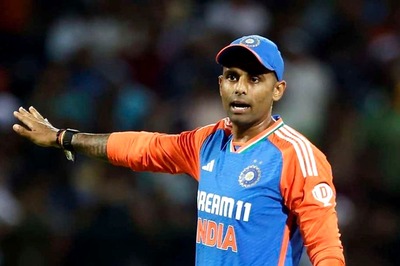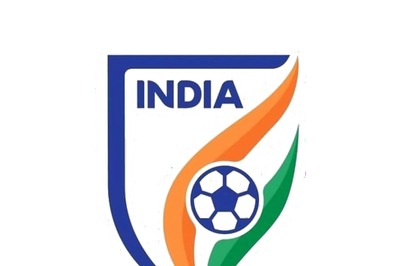
views
“I can’t learn Hindi for your convenience; learn Tamil if you want!” Tamil superstar Thalapathy Vijay’s dialogue in his latest movie, Beast, has set the tone once again for the already raging “Hindi imposition” controversy in the country.
The scene shows Veera Raghavan (Vijay) talking to a terrorist in Hindi, but the punchline comes a few seconds later, when an “irritated” Raghavan snaps back, saying he cannot keep translating every time and that he should go and learn Tamil.
All this furore on speaking Hindi and its imposition began after Union Home minister Amit Shah’s comment that Hindi should be accepted as a “link” language in India, rather than English.
This has raised a lot of sound and fury, especially in the southern states.
THE CONTROVERSY
Senior leaders across southern states namely former Karnataka chief minister Siddaramaiah, Kerala CM Pinarayi Vijayan, Tamil Nadu CM MK Stalin have expressed their objections towards Hindi being “imposed on” non-Hindi speaking states. Every time the language controversy surfaces, the social media trends with hashtags StopHindiImposition and StopHindiDivas across micro-blogging platforms.
Tamil Nadu’s stand-off with the Centre and resistance towards Hindi has given the controversy a lot more.
Southern leaders like JDS’s H D Kumaraswamy, Congress’s Dinesh Gundurao, DMK’s Kanimozhi and Stalin call the Centre’s move to popularise Hindi “a symbol of linguistic arrogance”.
Karnataka had also seen a series of anti-Hindi protests under the tagline ‘Namma Metro Hindi Beda’, where Hindi signages on the Bengaluru Metro were painted in black.
Kerala, perhaps, is one of the few states where the language controversy has not been effective. Although Vijayan earlier commented that Shah’s Hindi pitch as a national language was “a planned attempt to divert the country’s attention from more pressing issues”, the issue did not have a major effect like its neighbouring Tamil Nadu.
“It is all political repartee. Politicians love to use religion and language to divide people. Let’s not fall into their trap,” said a senior Bharatiya Janata Party (BJP) leader from Karnataka. Even Tamil Nadu’s BJP unit president K Annamalai said the state will not allow Hindi imposition. He did soften his stand in line with his central leadership’s views where he claimed that the Congress had politicised Hindi as a language issue for over 40 years.
“PM Narendra Modi did not approve the draft of the National Education Policy, which initially mentioned Hindi as the main language. If we require Hindi for work, education or other purposes, we can learn it, but it just can’t be imposed. You do not need a language to prove we are Indians,” he told News18.
THE KERALA EXAMPLE
An example of how Hindi is merely a political tool, not a problem at hand can be highlighted with Kerala’s ‘Changathi’ project launched by Kerala Literacy Mission. Migrant labourers, who come from Bihar, Jharkhand, Assam and West Bengal to Kerala, were being trained to read, write and speak Malayalam to help find or retain their jobs in the coastal state.
I spoke to a few such Bihar-Jharkhand-born students of Malayalam, who mentioned how learning the local language helped them get more jobs. Data from the Kerala government showed that around 2,934 migrant labourers had enrolled in the Malayalam classes during the Covid lockdown.
Let us go by the statistics of the 2011 Census of India on the linguistic breakdown in the country. On June 26, 2018, the Office of the Registrar General and Census Commissioner of India released the 2011 Census data on Language and Mother Tongue — the data that represents the rise and decline of languages over the years.
There are close to 54 crore Hindi speakers in the country, who account for 43.63% of India’s language pie chart, Bangla comes second with 8.03% speakers, followed by Marathi (6.86%) , Telugu (6.70%) and Tamil (5.70%).
Linguistic researchers highlight how Tamil has a special status in India’s cultural and linguistic history. Tamil is the oldest surviving language in the country and has not received the needed attention from the central government. Interestingly, the language that has shown a small decline in speakers is Gujarati.
It is important to note that the comment was made by Shah first in 2021, when he advocated the idea of ‘One Nation, One Language’ and stressed that only Hindi could unite the whole nation. “If the Prime Minister could speak Hindi globally, what are we embarrassed of,” the Home Minister had asked in September 2021.
But his most recent comment that there “was no conflict between Hindi and other Indian languages and that it could progress only through the approach of complementary coexistence” did not assuage southern leaders who have been using “Hindi imposition” as a political tool.
“When we adopted the Constitution, we also accepted the decision on September 14, 1949 to have Hindi as the country’s official language and Devanagari as the script. The decision was taken following an extensive debate, at the core of which was the basic understanding that there was no competition between Indian languages,” Shah had said in an earlier interview, adding all languages strengthened one another, and it was not about forcing Hindi on people.
CHANGE IS HERE?
It would be interesting to note that there has been a marked change in the number of elected representatives, especially MPs, to express themselves in their native languages, be it their swearing-in ceremonies or their address in Parliament. The Central government had also made it clear that the New Education Policy stressed on the use of regional and official languages, particularly the mother tongue, for imparting education till Class 5.
A senior central government official, who is in the know of the NEP drafting policies, said the same would apply to technical courses. “In at least eight states in India, courses in Hindi, Tamil, Telugu, Bengali and Marathi are being given as an option,” the official said.
Among the 10 languages that are spoken by a large population in India, data with the Union government indicates there has been a 25% rise in Hindi speakers. Between 2001 and 2011, Hindi grew at a rate of 25%, adding about 100 million new Hindi speakers. Sanskrit is the only language that is spoken by a set of around 25,000 people in the entire country.
Over the past few decades, the movement of people from North to South India has considerably increased, which has led to increased presence of Hindi speakers in the southern region. Another senior leader from a South-based regional party said, “Take a look at the Census data, the number of Hindi speakers in Tamil Nadu has doubled between 2001 and 2011. Many officers in central government postings also converse in Hindi with their subordinates. The issue of Hindi imposition is much ado about nothing.”
Read all the Latest News India and Breaking News here


















Comments
0 comment